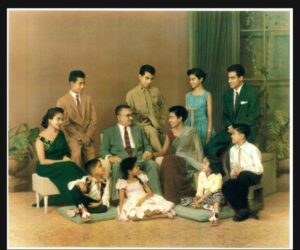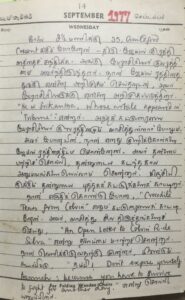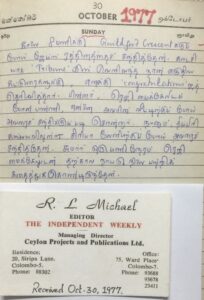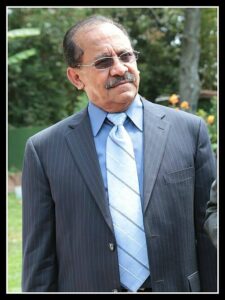Noted Bibliophile and a Valued Mentor
by Sachi Sri Kantha, June 7, 2025
Introduction
My destiny to meet and interact with James T Rutnam came in the aftermath of the August 1977 anti-Tamil riots. Previously, I had written a little about the anti-Tamil riots that engulfed the island then, and my initial attempts to make a grade as a writer in English. [Please check this link. https://sangam.org/s-p-amarasingam-1977-anti-tamil-pogrom/].I wrote to Mr. S.P. Amarasingam, the editor of the Tribune (Colombo). At that time, I was unaware that James Rutnam was an influential contributor to the Tribune, since its inception in 1954.

James Rutnam family with his 8 children (the one on the ground wearing striped long pants is his granddaughter) Jayam, second from the left, wearing brown coat. Photo is probably taken in the late 1950s.
Then, I was a 24 year old, inexperienced youth somewhat devoid of tact. Mr. Rutnam was 72 then, and had experienced life’s struggles and nuances of human aggressiveness as well as weaknesses. Now, that I had reached 72 this year, I consider it my heavenly blessing that I was so lucky to meet and interact with him in my salad days. One particular detail I had read, attracted me to Rutnam’s brand of activism by pen. It was this.
When he was serving as the Principal of St. Xavier’s College (Nuwara Eliya), Rutnam had written a letter to Mahatma Gandhi (1869-194) on April 11, 1931 on the issue of religious freedom. And that great soul had taken the trouble to reply to him publicly on May 3, 1931, in the Young India paper (which Gandhi himself edited), after publishing Rutnam’s letter in his journal. Complete details of this exchange between Rutnam and Mahatma Gandhi is available in Collected Works of Mahatma Gandhi, vol. XLVI (1931), pp 77, 109 and 110. It is also reproduced in James Thevathasan Rutnam Felicitation Volume (1975, Jaffna Archaeological Society, 158 pp), which he offered me as a gift in 1981.
My Rutnam’s Mementos
The dictionary defines a memento as an ‘object serving as reminder or warning, or kept as memorial of person or event.’ I have three Rutnam’s mementos. The first one, an autographed copy of his ‘James Thevathasan Rutnam Felicitation Volume’ (1975), published by the Jaffna Archaeological Society, and released in July 1980. The other two are his letters, written in 1977. One of these, is his handwritten brief note to journalist Mervyn de Silva, to introduce me. The second one, Rutnam’s personal letter of acknowledgment (dated Sept 9, 1977) to my appreciation-apology letter to him. Unfortunately, I had lost the original during my peregrinations, but had saved a smudged copy of the original. I provide pdf copies of these two Rutnam letters nearby. All three were of personal value to me, and had served as amulets for my career progress in science and journalism.
James Rutnam’s Sept 9, 1977 letter to Sachi
For easy reading, I reproduce the complete text of Mr. Rutnam’s letter below.
“9 September 1977
Dear Mr. Sri Kantha,
Thank you for your letter dated 6 September and for the kind words you write about my own humble contribution to the cause of persecuted human beings in the world. I am really a humanist and have always been on the side of those persecuted or discriminated against on account of the accident of birth.
I would certainly wish to meet you one of these days. I am usually at home in the mornings. I should tell you that I like your article giving an analysis of the Tamil votes in the last election. The Editor showed it to me before publication and I agreed with him that it should be published.
Regarding the Statement that fifteen of us made I must say it was meant to be like oil poured on troubled waters. I believe it that served a purpose. You will note that it the Statement we did not challenge the leadership of the Tamils nor of the Sinhalese. We only proposed a dialogue without any reservation.
If you read the series of my articles in the Tribune which began on 2 July, you will note my point of view. I realize from your letter that you appreciate my position. I am so glad of this. I must here say that at seventy-three I move very much among the younger people, especially in the Jaffna Campus where I am a member of an Academic Committee. I was much impressed by the few articles you had been publishing recently and have great hopes about your future.
Yours sincerely,
James T Rutnam”
Certainly, the final sentence of Rutnam’s letter was like ‘an inspirational garland’ for me, from this seasoned agitator/campaigner in Ceylon. I read it to my father immediately, and he advised me to visit Mr. Rutnam at the earliest.
Background story that elicited My Letter to James Rutnam
Only ten years ago, I picked up the wonderful lines written English poet and cleric John Donne (1572-1631) about letters. It was ‘More than kisses, letters mingle souls…’ But, I had experienced this effect with my first letter to James Rutnam, written on Sept 6, 1977; written in English, it combined sentiments of appreciation and apology. Unfortunately, I don’t have a draft or copy of this particular letter now. How could I infer then, that this one page letter could have such an influence on my future path? I had an old Remington manual non-electric typewriter, and simply without thinking of taking a carbon copy, I had typed my letter and sent it to Mr. Rutnam. The background story for this letter needs recording here.
In the aftermath of Aug 1977 anti-Tamil riots, the Tribune (Aug 27, 1977) carried a box column with the title ‘An Appeal by Tamil Residents in Colombo’. This was a statement signed by 15 prominent ‘Colombo Tamils’ of that era. As a young Tamil nationalist, I didn’t like some sentences that appeared in this ‘Appeal’. So, I scribbled my criticism of this statement and sent it to Mr. Amarasingam immediately. To my ‘agony and ecstasy’, Mr. Amarasingam incorporated my criticism into his ‘Editor’s note book’ feature and published it, identifying me as ‘a young Tamil youth S. Sri Kantha’ (Tribune, Sept 3, 1977, pp. 2-6).
I list below those 15 prominent ‘Colombo Tamils’ of that era, wherever possible their societal rank and life span in years.
Rev. James Soundaranayagam Mather (1890-1986) – Methodist Minister
Dr. R. Pararajasegaram (1928-2020) – elite ophthalmologist
Dr. William Dharmarajah Ratnavale (1913-1995) – military physician, pathologist
P. Navaratnarajah (1908-1994) – prominent lawyer, QC.
P. Karalasingam
V. Sivasubramaniam (1908-1985) – lawyer and judge of the Supreme Court
P. Nagendran
Anton Muttucumaru (1908-2001) – Ceylon’s first commander of the Army
V. Manicavasagar (1906-1993) – lawyer and puisne judge of Supreme Court
James T. Rutnam (1905-1988) – political activist, businessman, independent scholar
J.K. Ratnanadan
A.C. Nadarajah – prominent lawyer, ex- Vice President of SLFP
M. Rajendra (1911-1991) – Civil servant and brother of M. Tiruchelvam QC.
M. Rajanayagam
S. Sellamuttu (1916-1993) – Mayor of Colombo in 1951, and boss of Ceylon Theatres.
I had itemized my beef with these ‘elite Colombo Tamils’, as recorded in my outburst to the editor of Tribune [Sept 3, 1977, p.4] as follows (words in bold fonts, as in the original):
“These so-called ‘Tamil residents in Colombo (better if they would have put, Colombo 7 and 3 or 5) have the following common features.
1. Almost all of them have passed their prime (i.e. above 6-age level) just marking time for their last visit to ‘Kanatte’ (I certainly have respect for these distinguished citizens; if the wording is strong, please forgive me)
2. Their palatial mansions, located in spacious Colombo 7 and 3 or 5, had not been attacked or looted by unscrupulous elements, who went on rampage
3. Except for the two James’ (Rev. Mather and Rutnam), others have retired (or, on the verge of retiring) from active life, just passing time by sending reports to press, seated in arm chairs. They hardly come into contact with the younger generations, of the lower income group, from both the communities.
4. All of them had their education in English- with their Sinhalese friends in the same class rooms and lecture rooms; and would have sipped Scotch whisky with the socially elevated Sinhalese group only.
5. Most of their progeny are doing well, not in our Sri Lanka, but abroad, hence not exposed to the racial in-breeding tension prevailing here.
Are these retired Supreme Court judges, Queen Counsels, Doctors, Retired Civil Servants and Business Magnates, who are going to form the nucleus of the future generation of Sri Lanka – Definitely no!
The writer, a 24-year old youth, claims to have the authority to speak on behalf of the down-trodden frustrated youth (whom you depict as ‘youthful fanatics’), being educated in swabasha, being victimized by standardization, and also in job opportunities (by Mrs B’[andaranaike] Govt.), even after obtaining a science degree from our own University of Sri Lanka…”
When I read this stuff now, in hindsight, I feel a bit ashamed for the derisive euphemistic language I had used then. Certainly the usage ‘just marking time for their last visit to ‘Kanatte’ was offensive. Non-Sri Lankans cannot comprehend the euphemistic tag ‘Kanatte’. In Colombo, it is the location of the largest cemetery. But, Mr. Amarasingam (in his wisdom) had allowed my choice words to stand as it is, probably to focus the anger of a Tamil youth. Subsequently, he advised me to choose moderate, non-partisan words, if my objective was/is to convince those with rational minds. He also taught me another lesson: ‘By using harsh words, you’ll only be preaching to the choir, or teaching to the converted. You cannot achieve more than that.’
Excerpts from My 11 diary entries (1977-81) featuring Mr. Rutnam
I provide below excerpts from 11 diary entries I had made between 1977 and 1981, that feature my interactions with Mr. Rutnam. My last face to face meeting with him was on January 18, 1981, in Colombo.
Sept 7, 1977 Wed.
Yesterday I sent an ‘appreciation-apology’ letter to Mr. James Rutnam. I tendered my apology to him, for the criticism published in the recent issue of ‘Tribune’, carrying my name. It would be an ingratitude if I forget the services he had rendered to the Tamils and the Tamil language.
Sept 14, 1977 Wed [ a photo scan is provided nearby]

Sachi’s diary entry Sept.14, 1977
Went to 35, Guildford Crescent at 8:30 am, to meet Mr. James Rutnam. Prof. Kularatnam was also there. I introduced myself to James Rutnam. Then, he introduced me to Professor, noting ‘He is Sri Kantha, whose article appeared in the ‘Tribune’.’ I guess Prof. Kularatnam also had read my contribution. After he left, I told my objectives [in writing that criticism] to him. Then, he described about his past activities, experiences, and all. He also showed me his book collections. I showed him the piece I had written entitled ‘Crocodile Tears from Colvin’. He read it, made corrections, and suggested to revise the title as ‘An Open Letter to Colvin R. de Silva’. Before I was about to leave, he called me to tell ‘Thambi! Don’t expose yourself too much; because you have to survive to fight for another day’, and sent me off.
Sept 20, 1977 Tue
Went to the ‘Tribune’ office. Editor Amarasingam was there. He told me that the Asiaweek (Sept 2, 1977) issue was ‘blocked’ at the Customs, and gave me two news items in it. Mr. James Rutnam was also there.
Sept 21, 1977 Wed
James Rutnam’s Sept 21, 1977 letter to Mervyn de Silva, introducing Sachi.
Visited James Rutnam, and showed him two articles which I’ve written. One was based on the talk I had with him yesterday, and had a caption ‘Which is a national Party in Sri Lanka?’. The second one was my criticism on the contribution of Fr. Tissa Balasuriya, that had appeared in the ‘Sunday Times’. Rutnam read both, and commented – ‘Both are good. Let’s publish both’; and suggested to hand over the ‘National Party’ piece at the Tribune office. The rebuttal to Fr. Balasuriya to be given at the ‘Times of Ceylon’ office. He also gave me an introduction to Mr. Mervyn de Silva (editor, Times of Ceylon). For some reason, I was reluctant to go to the Times building. Went to meet Mr. Amarasingam. He had read my piece, and suggested to revise the ‘style’: ‘Rather than being offensive, it should be a ‘suggestion’. [I provide a PDF scan of Rutnam’s hand written letter in his letter head to Mervyn de Silva, which I had retained without delivering it to its addressee. The short message in it, read:
“21/9/77
My dear Mervyn,
Bearer Mr Sri Kantha is well known to me. He is a promising journalist. He is bringing an article which takes a different view of Fr. Balasuriya’s contention.
James”]
Sept 22, 1977 Thr
James Rutnam had asked me to come at 8:00 am. But, I didn’t go. The reason: I had to revise my piece, for submission to the Tribune. As Amarasingam advised, reluctantly I wrote a ‘mild title’ – ‘Suggestions to the National Parties of Sri Lanka’. Went to Tribune office and handed the item. He read it and accepted with the words ‘OK’.
Sept 23, 1977 Fri
Visited James Rutnam at 9:00 am. He chided me, for not ‘keeping yesterday’s appointment’. I told him the reason. He did accept my explanation, but advised me – ‘If that’s so, then you should have phoned me to inform your unavailability.’ He had a point. But the problem I faced was – I don’t have a phone at home. To make a phone call, I had to go to nearby Havelock Town post office.
Oct 30 1977 Sun [a photo scan is provided nearby]

Sachi’s diary entry Oct. 30, 1977
At 8 am, went to Guildford Crescent to meet James Rutnam. He congratulated me for the recently published ‘Tribune’ articles. Then, he called [journalist] Reggie Michael, and asked me to visit him at his home. I went to Siripa Lane at Thimbirigasya to meet him. For an hour, I talked with him about recent events that occurred in the country.
Few Explanatory Notes
Other than Amarasingam (the editor of Tribune), individuals mentioned in my diary entries include, Fr. Tissa Balasuriya, Dr. Colvin R de Silva, Mervyn de Silva and Reggie Michael. Fr. Tissa Balasuriya (1924 – 2013) was a Sinhalese Catholic priest and social activist. During my period as a student at the Aquinas University College (1970-71), he was it’s Rector. In 1977, he gained notoriety among the Tamils mostly, for ‘inferring’ that the votes for Tamil United Liberation Front (TULF) at the 1977 General Election was NOT for a separate state of Eelam. In the Tribune issues, along with journalist S. Sivanayagam, Batticaloa priet Bro. Joseph Mary, I disagreed with Fr Balasuiya’s ‘manipulated statistics’.
As every Sri Lankan knows, Dr Colvin R de Silva (1907-1989) was the Trotskyist politician and the father of the 1972 Republican Constitution of Sri Lanka. I wrote a critical essay on Colvin’s pronouncements during 1977, which James Rutnam checked and approved as worthy for publication. First, he suggested me to approach journalist Mervyn de Silva (1929-1999). It escapes me now, why I hesitated to meet Mervyn in 1977. [That in 1980s and 1990s, my pro-Tamil views/letters were regularly published by Mervyn in his vehicle Lanka Guardian was a different story.]
Due to my reluctance to meet Mervyn de Silva, Mr. Rutnam then arranged me to meet another recognized name in island journalism – Mr. Reggie Michael, a Christian Tamil like Rutnam. This I did. Around that time, after his stint at the editorial desk of Ceylon Daily Mirror, Michael was hired as the editor of a weekly ‘The Independent’ – the short lived English version of ‘Sutantiran’ by S.J.V. Chelvanayakam’s publishing arm. Following the death of Chelvanayakam in April 1977, if I’m not wrong, ‘The Independent’ lost clout with the new management, and folded within an year or two. Prior to that, Reggie Michael did publish my ‘Open Letter to Comrade Colvin’ in the Independent issue of Nov 18, 1977. Unfortunately, not much information is available now about the biographical details of Reggie Michael. His alliterative editorials and opinions were a rage for English readers in Ceylon during 1960s. When I met him, he was of medium height, with a twinkle in his lips and was a wonderful conversationalist.
[Interlude]
From May 1977, I had shifted my base to Peradeniya, and I was leading a sort of ‘double life’ – five week days in Peradeniya, and the weekend in Colombo. Considering the time spent in traveling between Colombo and Peradeniya by either train or bus, and attending to other social activities related to arranging my Tamil book ‘Thamil Isai Theepam’ release function in August 1978, I hardly had time to visit Mr. Rutnam during the weekends.
July 19, 1978 Wed
Today is Poya-day holiday. Went to the house of Mr. M. Sivasithamparam at Norris Canal Road. He was not there. But, handed a copy of my book to his wife. Then, went to Guildford Crescent to meet Mr. James Rutnam, after many months. I mentioned about my forthcoming book release function, to be held combined with the end of Centenary of Birth celebration of Ananda Coomaraswamy. He bought a book copy and asked me to autograph it. This was the 3rd copy, which was sold. He suggested to visit architect V.S. Thurairajah, and called him to give an introduction about me. At 10:00 am, I visited Mr. Thurairajah for the first time. He also bought an autographed 4th copy of my book.
Nov 27, 1978 Mon
Visited with James Rutnam at 8:30 am. I inquired about the next International Tamil Research Conference, because he was a Joint Secretary of the Sri Lanka unit of the International Association for Tamil Research (IATR). He mentioned, most probably the next scheduled meeting in London will NOT take place. It will be held probably in January 1980 at Madurai, under the auspices of MGR government. As such, he asked me to prepare my research paper ahead of time. Then, both of us went to the Tribune office. Unfortunately, Mr. Amarasingam was not there.
Jan 3, 1981 Sat
Today, I’m leaving for India, to participate in the 5th International Tamil Conference on Tamil Studies, which is scheduled to commence in Madurai, tomorrow….Took Air Lanka flight from Colombo to Trivandrum; started by 3:45 pm and we landed at Trivandrum by 4:15 pm. We had to spend nearly three and a half hours at the airport. James Rutnam introduced me to Prof K. Indrapala….
Jan 18, 1981 Sun
Went to meet Dr James Rutnam at Barnes Place. First I had to locate his residence. I found it after some search, at 11/1, Mr. A[lbert] A. Page’s palatial mansion. He presented to me a copy of his ‘James Thevathasan Rutnam Felicitation Volume’ (1975), published by the Jaffna Archaeological Society, and released in July 1980. It is a precious gift for me. I immediately scanned through the ‘Bibliography of the published writings of James T. Rutnam’, compiled by A. Sivanesachelvan. It numbered up to 127 titles, spreading through a span of 53 years, from 1922 to 1975.
Aftermath
I had few regrets. First, for want of a personal camera, I couldn’t take a joint photo with James Rutnam. Secondly, though it was in my mind to say farewell to him, before I left the island in August 1981, due to pressing needs of other related engagements, I never had an opportunity to meet Mr. Rutnam face to face. Thirdly, though I did visit Colombo in 1986 and 1987, due to personal issues that needed ‘immediate attention’, it escaped my mind to contact him. I felt so sad, when I heard that Mr Rutnam died on Nov 4, 1988, at the age of 83. From an eulogy written by Prof. Bertram Bastiampillai, I learnt that Mr. Rutnam suffered from Parkinson disease and suffered a paralytic stroke, in his final years. I could console myself how an appreciation cum apology letter I wrote in 1977, enabled me to be a benefactor of a mercuric brain that touched bases with history’s noted figures like Mahatma Gandhi and Che Guevara.

Jayam Rutnam, son of James Rutnam
Few months ago, due to a request received from Prof. Michael Roberts, I was able to correspond with Mr. Rutnam’s son Jayam Rutnam (living in Los Angeles). I sent him a mail on March 30th. Excerpts:
“Hello Jayam,
Greetings from Tokyo. Just now, I had a glance at your website, and located your email link. I’m Sachi (Sri Lankan Tamil) and I have known your dad James T. Rutnam, from 1977 to 1981, while I was in Colombo. I considered him as one of my mentors. I was in my 20s then, and he was a guide to me in my activism. Now, I’m 71…May I know, how old are you now?”
I received a response from Jayam Rutnam, on April 9th. Excerpts:
“Hi Sachi
So nice to hear from you. I will be 85 in June. I am very glad to hear
from you. My Dad did speak of you and I have seen the ‘altered’ version of Nilaperumal in the Tami Net website! My Dad was very fond of you…
Best wishes”
The ‘Nilaperumal’ referred to by Jayam Rutnam in his mail was a classic genealogical study his father James Rutnam on the ancestry of Bandaranaike clan, It was originally published in the Tribune of July 19, 1957; and re-published digitally in the Sangam site [July 18, 2002], with my front note and postscript. The link is as follows:
https://www.sangam.org/ANALYSIS/Sachi07_18_02.htm
What a delight to hear this appreciation from 85 year old Jayam Rutnam! I remember James Rutnam’s 120th birth anniversary with gratitude and he continues to live via his literary contributions to Sri Lankan history and archeology.
****
I apologize to the readers for the silly typo errors.
1) Mahatma Gandhi’s life span should be (1869-1948).
2) In my criticism of ‘Colombo Tamils’ that appeared in the Tribune (Sept , 1977), item #1 – should read ‘Almost all of them have passed their prime (i.e. above 60 -age level) just marking time for their last visit to ‘Kanatte’. Zero was missing, after the number 6.
Also, specific indications of the then zone codes of Colombo – 7 and 3 or 5, were
euphemism for the residences/palatial mansions of affluent Colombo Tamils and other filthy rich personalities of other ethnic groups.